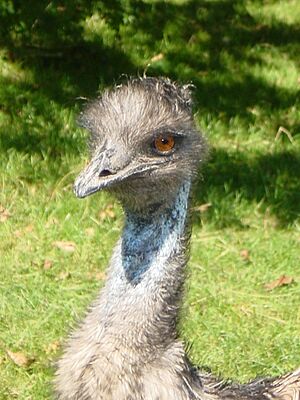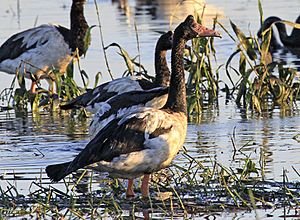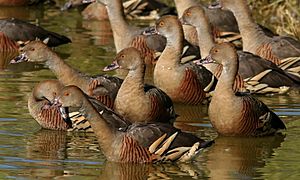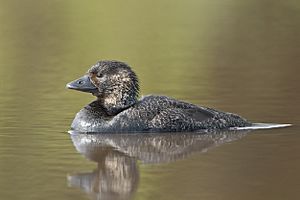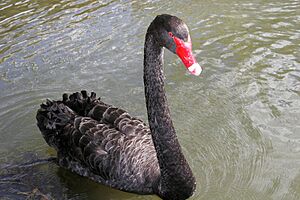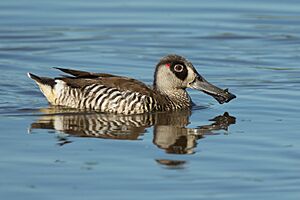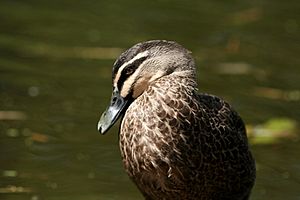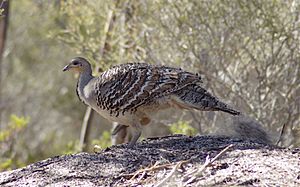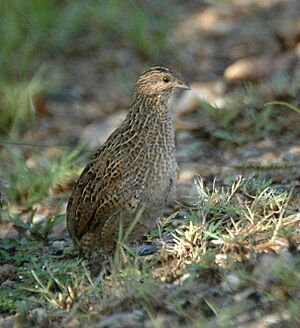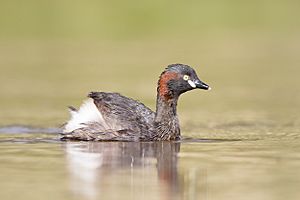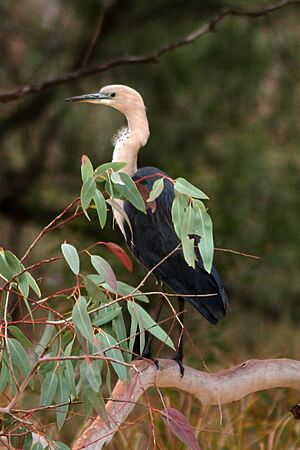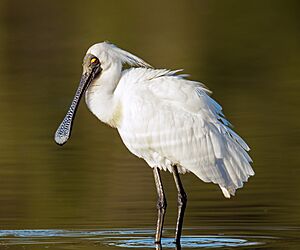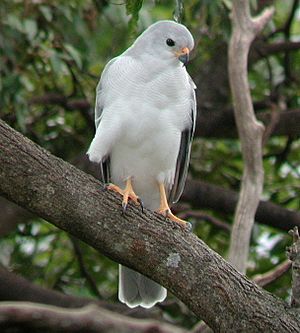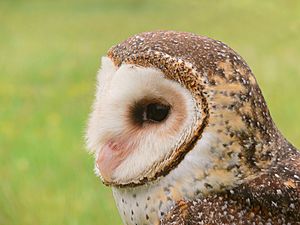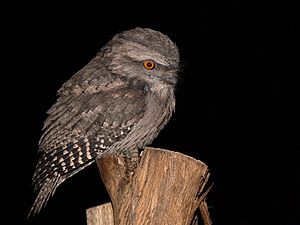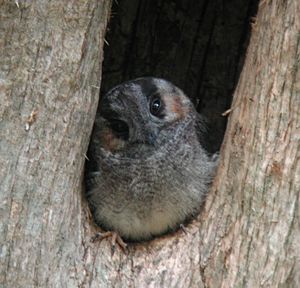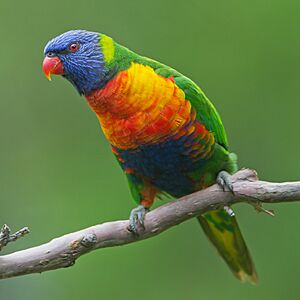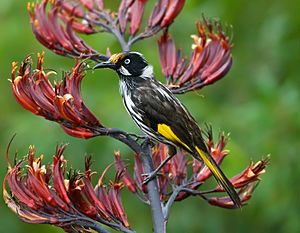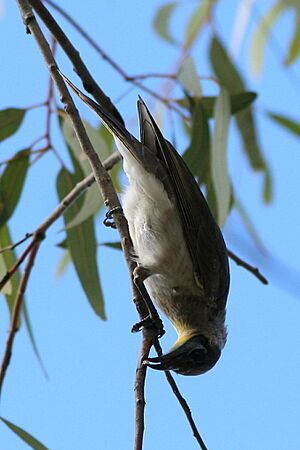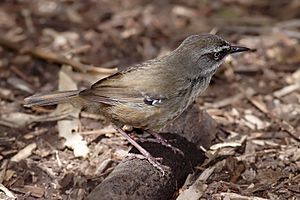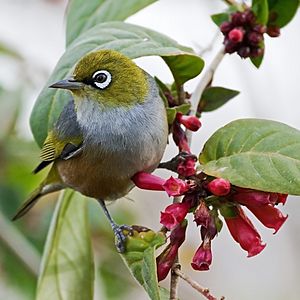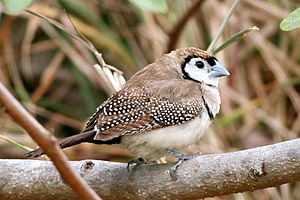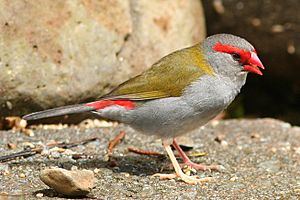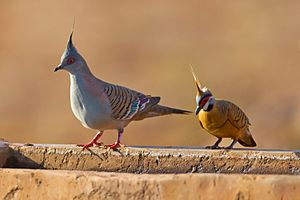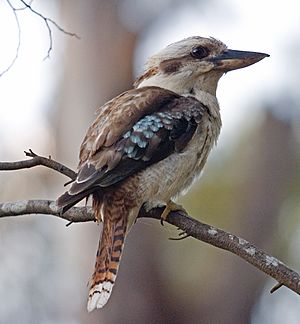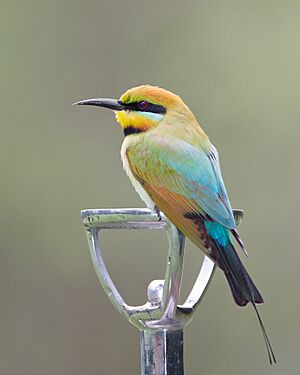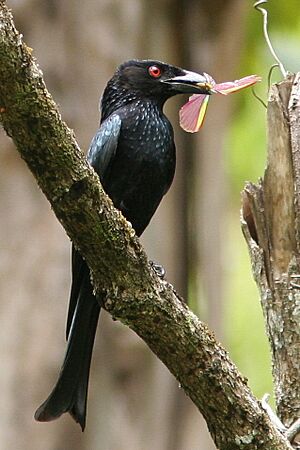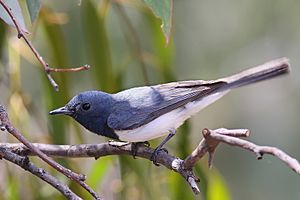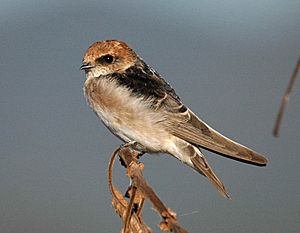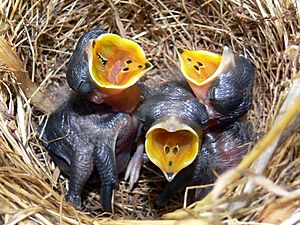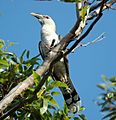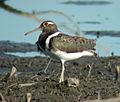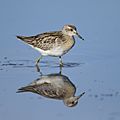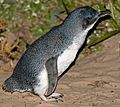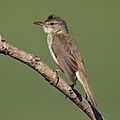List of birds of Western Australia facts for kids
Western Australia is a huge place, and it's home to an amazing variety of wild birds! This list will help you discover many of them. We'll explore different types of birds, from the biggest flightless ones to tiny, colorful parrots. You'll learn about native birds that live here all the time, and also some special visitors or birds that were brought here by people.
There are over 600 different bird species found in Western Australia! That's a lot of birds to spot. The way these birds are grouped and named follows a system called The Clements Checklist of Birds of the World.
Here are some special tags you'll see next to some bird names. Most native birds that are commonly seen don't have a tag.
- (A) Accidental – This bird doesn't usually live in Western Australia. It's a rare visitor, maybe blown off course by a storm!
- (E) Endemic – This bird is super special! It's found only in Western Australia and nowhere else in the world.
- (I) Introduced – These birds were brought to Western Australia by people, either on purpose or by accident. They weren't originally from here.
- (Ex) Extirpated – This bird used to live in Western Australia, but it doesn't anymore. However, you can still find it in other parts of the world.
- (X) Extinct – Sadly, this bird no longer exists anywhere in the world.
Contents
- Meet the Big Birds: Ostriches, Emus, and Geese!
- Ground Birds and Their Habits
- Water Birds: Grebes, Pelicans, and More
- Birds of Prey: Hunters of the Sky
- Night Birds: Owls and Frogmouths
- Colorful and Chatty Birds: Parrots and More
- Small and Songful Birds
- Other Interesting Birds
- Pigeons and Doves: Common City Dwellers and Bush Birds
- Cuckoos: The Brood Parasites
- Kingfishers: Brightly Colored Fishers
- Bee-eaters: Insect Hunters
- Drongos: Mimics and Hunters
- Monarch Flycatchers: Catching Insects on the Wing
- Australasian Robins: Colorful Forest Friends
- Swallows: Graceful Fliers
- Wagtails and Pipits: Ground Feeders
- Images for kids
Meet the Big Birds: Ostriches, Emus, and Geese!
Ostriches: Not from WA, but Here Now!
Ostriches are not originally from Western Australia. But some have escaped from farms and now live in the wild! They are the biggest birds in the world, known for their long legs and fast running.
| Common name | Binomial | Notes |
|---|---|---|
| Common ostrich | Struthio camelus | (I) |
Emus: Australia's Famous Flightless Bird
The emu is Australia's second-largest bird and cannot fly. It's a close relative of the cassowary, which lives in New Guinea. Emus are found all over Australia, including Western Australia.
| Common name | Binomial | Notes |
|---|---|---|
| Emu | Dromaius novaehollandiae |
Magpie Goose: A Unique Water Bird
The magpie goose is a very old and special type of water bird. It's found across Australia and is known for its black and white feathers.
| Common name | Binomial | Notes |
|---|---|---|
| Magpie goose | Anseranas semipalmata |
Ducks, Geese, and Swans: Water Lovers
This family includes all the ducks, geese, and swans you might see. They are perfectly built for life in the water! They have webbed feet for swimming and special feathers that shed water easily.
| Common name | Binomial | Notes |
|---|---|---|
| Plumed whistling-duck | Dendrocygna eytoni | |
| Wandering whistling-duck | Dendrocygna arcuata | |
| Cape Barren goose | Cereopsis novaehollandiae | |
| Freckled duck | Stictonetta naevosa | |
| Mute swan | Cygnus olor | (I) |
| Black swan | Cygnus atratus | |
| Radjah shelduck | Radjah radjah | |
| Australian shelduck | Tadorna tadornoides | |
| Green pygmy-goose | Nettapus pulchellus | |
| Australian wood duck | Chenonetta jubata | |
| Garganey | Spatula querquedula | (A) |
| Australasian shoveler | Spatula rhynchotis | |
| Northern shoveler | Spatula clypeata | (A) |
| Eurasian wigeon | Mareca penelope | (A) |
| Pacific black duck | Anas superciliosa | |
| Mallard | Anas platyrhynchos | (I) |
| Northern pintail | Anas acuta | (A) |
| Gray teal | Anas gracilis | |
| Chestnut teal | Anas castanea | |
| Pink-eared duck | Malacorhynchus membranaceus | |
| Hardhead | Aythya australis | |
| Blue-billed duck | Oxyura australis | |
| Musk duck | Biziura lobata |
Ground Birds and Their Habits
Megapodes: The Mound Builders
Megapodes are special birds that build huge mounds of dirt and plants to keep their eggs warm. They don't sit on their eggs like other birds! You can find different kinds of megapodes in Australia and nearby islands.
| Common name | Binomial | Notes |
|---|---|---|
| Malleefowl | Leipoa ocellata | |
| Orange-footed scrubfowl | Megapodius reinwardt |
Guineafowl: Another Introduced Species
Guineafowl are not native to Australia. But like ostriches, some have formed wild groups in Western Australia.
| Common name | Binomial | Notes |
|---|---|---|
| Helmeted guineafowl | Numida meleagris | (I) |
Pheasants, Grouse, and Quails
This group includes pheasants and quails. They are usually plump, ground-dwelling birds with short wings. Many of them are hunted for food or kept as farm birds.
| Common name | Binomial | Notes |
|---|---|---|
| Indian peafowl | Pavo cristatus | (I) |
| Brown quail | Coturnix ypsilophora | |
| Blue-breasted quail | Excalfactoria chinensis | |
| Stubble quail | Coturnix pectoralis | |
| Ring-necked pheasant | Phasianus colchicus | (I) |
Water Birds: Grebes, Pelicans, and More
Grebes: Amazing Divers
Grebes are small to medium-sized birds that love freshwater. They are incredible swimmers and divers, using their special lobed toes. But because their feet are so far back on their bodies, they look a bit clumsy on land!
| Common name | Binomial | Notes |
|---|---|---|
| Little grebe | Tachybaptus ruficollis | (A) |
| Australasian grebe | Tachybaptus novaehollandiae | |
| Hoary-headed grebe | Poliocephalus poliocephalus | |
| Great crested grebe | Podiceps cristatus |
Pelicans: Big Bills, Big Pouches
Pelicans are very large water birds. They are easy to spot because of the huge pouch under their bill, which they use to scoop up fish. Like other birds in their group, they have four webbed toes for swimming.
| Common name | Binomial | Notes |
|---|---|---|
| Australian pelican | Pelecanus conspicillatus |
Herons, Egrets, and Bitterns: Wading Birds
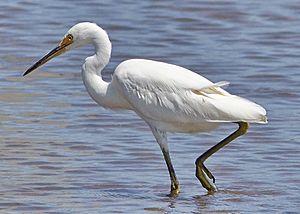

These birds are often found near water, wading in shallow areas to catch fish, frogs, and insects. They have long legs and necks, perfect for hunting in wetlands.
| Common name | Binomial | Notes |
|---|---|---|
| Australasian bittern | Botaurus poiciloptilus | |
| Yellow bittern | Ixobrychus sinensis | (A) |
| Black-backed bittern | Ixobrychus dubius | |
| Cinnamon bittern | Ixobrychus cinnamomeus | (A) |
| Black bittern | Ixobrychus flavicollis | |
| Gray heron | Ardea cinerea | (A) |
| Pacific heron | Ardea pacifica | |
| Great-billed heron | Ardea sumatrana | |
| Purple heron | Ardea purpurea | (A) |
| Great egret | Ardea alba | |
| Intermediate egret | Ardea intermedia | |
| White-faced heron | Egretta novaehollandiae | |
| Little egret | Egretta garzetta | |
| Pacific reef-heron | Egretta sacra | |
| Pied heron | Egretta picata | |
| Cattle egret | Bubulcus ibis | |
| Chinese pond-heron | Ardeola bacchus | (A) |
| Striated heron | Butorides striatus | |
| Black-crowned night-heron | Nycticorax nycticorax | |
| Nankeen night-heron | Nycticorax caledonicus |
Ibises and Spoonbills: Unique Bills
These birds are also found near water. Ibises have long, downward-curving bills, while spoonbills have flat, spoon-shaped bills. Both are great for finding food in mud or shallow water.
| Common name | Binomial | Notes |
|---|---|---|
| Glossy ibis | Plegadis falcinellus | |
| Australian ibis | Threskiornis moluccus | |
| Straw-necked ibis | Threskiornis spinicollis | |
| Royal spoonbill | Platalea regia | |
| Yellow-billed spoonbill | Platalea flavipes |
Birds of Prey: Hunters of the Sky
Osprey: The Fish Hunter
The osprey is a powerful bird of prey that specializes in catching fish. You'll often see it soaring over water, then diving feet-first to grab its meal.
| Common name | Binomial | Notes |
|---|---|---|
| Osprey | Pandion haliaetus |
Hawks, Eagles, and Kites: Masters of Flight
This group includes many impressive birds of prey, like the mighty wedge-tailed eagle. They have sharp talons and keen eyesight, making them excellent hunters. They soar high in the sky, looking for food.
| Common name | Binomial | Notes |
|---|---|---|
| Black-shouldered kite | Elanus axillaris | |
| Letter-winged kite | Elanus scriptus | |
| Oriental honey-buzzard | Pernis ptilorhynchus | (A) |
| Black-breasted kite | Hamirostra melanosternon | |
| Square-tailed kite | Lophoictinia isura | |
| Pacific baza | Aviceda subcristata | |
| Little eagle | Hieraaetus morphnoides | |
| Wedge-tailed eagle | Aquila audax | |
| Swamp harrier | Circus approximans | |
| Spotted harrier | Circus assimilis | |
| Chinese sparrowhawk | Accipiter soloensis | |
| Gray goshawk | Accipiter novaehollandiae | |
| Brown goshawk | Accipiter fasciatus | |
| Japanese sparrowhawk | Accipiter gularis | |
| Collared sparrowhawk | Accipiter cirrocephalus | |
| Red goshawk | Erythrotriorchis radiatus | |
| Black kite | Milvus migrans | |
| Whistling kite | Haliastur sphenurus | |
| Brahminy kite | Haliastur indus | |
| White-bellied sea eagle | Haliaeetus leucogaster |
Falcons: Fast and Fierce Hunters
Falcons are known for their incredible speed and hunting skills. They have pointed wings and can dive at high speeds to catch other birds in mid-air.
| Common name | Binomial | Notes |
|---|---|---|
| Nankeen kestrel | Falco cenchroides | |
| Eurasian hobby | Falco subbuteo | (A) |
| Australian hobby | Falco longipennis | |
| Brown falcon | Falco berigora | |
| Gray falcon | Falco hypoleucos | |
| Black falcon | Falco subniger | |
| Peregrine falcon | Falco peregrinus |
Night Birds: Owls and Frogmouths
Barn Owls: Silent Night Hunters
Barn owls are nocturnal birds, meaning they hunt at night. They have excellent hearing and silent flight, making them very effective predators in the dark.
| Common name | Binomial | Notes |
|---|---|---|
| Australian masked-owl | Tyto novaehollandiae | |
| Australian grass-owl | Tyto longimembris | |
| Barn owl | Tyto alba |
Owls: Wise Birds of the Night
Owls are another group of nocturnal birds of prey. They have large eyes that help them see in low light and can turn their heads almost all the way around!
| Common name | Binomial | Notes |
|---|---|---|
| Oriental scops-owl | Otis sunia | (A) |
| Rufous owl | Ninox rufa | |
| Barking owl | Ninox connivens | |
| Southern boobook | Ninox boobook | |
| Brown boobook | Ninox scutulata | (A) |
| Northern boobook | Ninox japonica | (A) |
Frogmouths: Masters of Disguise
Frogmouths are nocturnal birds that look a lot like owls, but they are actually related to swifts. They are famous for their amazing camouflage, blending in perfectly with tree bark during the day.
| Common name | Binomial | Notes |
|---|---|---|
| Tawny frogmouth | Podargus strigoides |
Owlet-Nightjars: Small Night Fliers
Owlet-nightjars are small, nocturnal birds found in Australia and nearby islands. They are also related to swifts and are active at night.
| Common name | Binomial | Notes |
|---|---|---|
| Australian owlet-nightjar | Aegotheles cristatus |
Colorful and Chatty Birds: Parrots and More
Cockatoos: Smart and Noisy Parrots
Cockatoos are a type of parrot known for their crests (feathers on their heads) and their loud calls. They are very intelligent birds and can be quite playful.
| Common name | Binomial | Notes |
|---|---|---|
| Red-tailed black-cockatoo | Calyptorhynchus banksii | |
| Carnaby's black-cockatoo | Calyptorhynchus latirostris | (E) |
| Baudin's black-cockatoo | Calyptorhynchus baudinii | (E) |
| Pink cockatoo | Lophochroa leadbeateri | |
| Galah | Eolophus roseicapilla | |
| Long-billed corella | Cacatua tenuirostris | (I) |
| Western corella | Cacatua pastinator | (E) |
| Little corella | Cacatua sanguinea | |
| Sulphur-crested cockatoo | Cacatua galerita | |
| Cockatiel | Nymphicus hollandicus |
Old World Parrots: Bright and Beautiful
This family includes many of Australia's colorful parrots, like rosellas and lorikeets. They are often found in forests and woodlands, feeding on seeds, fruits, and nectar.
| Common name | Binomial | Notes |
|---|---|---|
| Regent parrot | Polytelis anthopeplus | |
| Princess parrot | Polytelis alexandrae | |
| Red-winged parrot | Aprosmictus erythropterus | |
| Ground parrot | Pezoporus wallicus | |
| Night parrot | Pezoporus occidentalis | |
| Bourke's parrot | Neopsephotus bourkii | |
| Elegant parrot | Neophema elegans | |
| Rock parrot | Neophema petrophila | |
| Scarlet-chested parrot | Neophema splendida | |
| Australian ringneck | Barnardius zonarius | |
| Northern rosella | Platycercus venustus | |
| Western rosella | Platycercus icterotis | (E) |
| Naretha bluebonnet | Northiella narethae | |
| Mulga parrot | Psephotus varius | |
| Red-capped parrot | Purpureicephalus spurius | (E) |
| Budgerigar | Melopsittacus undulatus | |
| Purple-crowned lorikeet | Parvipsitta porphyrocephala | |
| Varied lorikeet | Psitteuteles versicolor | |
| Red-collared lorikeet | Trichoglossus rubritorquis | |
| Rainbow lorikeet | Trichoglossus haematodus | (I) |
Small and Songful Birds
Fairywrens: Tiny and Vibrant
Fairywrens are small, active birds, often with bright blue or red feathers. They live in family groups and are a joy to watch as they hop through bushes.
| Common name | Binomial | Notes |
|---|---|---|
| Rufous grasswren | Amytornis whitei | |
| Striated grasswren | Amytornis striatus | |
| Short-tailed grasswren | Amytornis merrotsyi | |
| Western grasswren | Amytornis textilis | |
| Black grasswren | Amytornis housei | (E) |
| Dusky grasswren | Amytornis purnelli | |
| Southern emuwren | Stipiturus malachurus | |
| Rufous-crowned emuwren | Stipiturus ruficeps | |
| Purple-crowned fairywren | Malurus coronatus | |
| Red-winged fairywren | Malurus elegans | (E) |
| Blue-breasted fairywren | Malurus pulcherrimus | |
| Purple-backed fairywren | Malurus assimilis | |
| Splendid fairywren | Malurus splendens | |
| White-winged fairywren | Malurus leucopterus | |
| Red-backed fairywren | Malurus melanocephalus |
Honeyeaters: Nectar Lovers
Honeyeaters are a large group of birds that mostly feed on nectar from flowers, using their brush-tipped tongues. They also eat insects and fruit. They are very important for pollinating plants!
| Common name | Binomial | Notes |
|---|---|---|
| Western spinebill | Acanthorhynchus superciliosus | (E) |
| Pied honeyeater | Certhionyx variegatus | |
| Kimberley honeyeater | Territornis fordiana | (E) |
| White-gaped honeyeater | Stomiopera unicolor | |
| White-fronted honeyeater | Purnella albifrons | |
| Purple-gaped honeyeater | Lichenostomus cratitius | |
| Yellow-throated miner | Manorina flavigula | |
| Spiny-cheeked honeyeater | Acanthagenys rufogularis | |
| Western wattlebird | Anthochaera lunulata | (E) |
| Red wattlebird | Anthochaera carunculata | |
| Singing honeyeater | Gavicalis virescens | |
| Yellow-plumed honeyeater | Ptilotula ornata | |
| White-plumed honeyeater | Ptilotula penicillata | |
| Yellow-tinted honeyeater | Ptilotula flavescens | |
| Gray-headed honeyeater | Ptilotula keartlandi | |
| Gray-fronted honeyeater | Ptilotula plumula | |
| Bar-breasted honeyeater | Ramsayornis fasciatus | |
| Rufous-throated honeyeater | Conopophila rufogularis | |
| Gray honeyeater | Conopophila whitei | |
| Gibber chat | Ashbyia lovensis | (A) |
| Yellow chat | Epthianura crocea | |
| Crimson chat | Epthianura tricolor | |
| Orange chat | Epthianura aurifrons | |
| White-fronted chat | Epthianura albifrons | |
| Black honeyeater | Sugomel nigrum | |
| Dusky myzomela | Myzomela obscura | (A) |
| Red-headed myzomela | Myzomela erythrocephala | |
| Tawny-crowned honeyeater | Gliciphila melanops | |
| Banded honeyeater | Cissomela pectoralis | |
| Brown honeyeater | Lichmera indistincta | |
| New Holland honeyeater | Phylidonyris novaehollandiae | |
| White-cheeked honeyeater | Phylidonyris nigra | |
| White-eared honeyeater | Nesoptilotis leucotis | |
| Blue-faced honeyeater | Entomyzon cyanotis | |
| White-throated honeyeater | Melithreptus albogularis | |
| Gilbert's honeyeater | Melithreptus chloropsis | (E) |
| Brown-headed honeyeater | Melithreptus brevirostris | |
| Black-chinned honeyeater | Melithreptus gularis | |
| Painted honeyeater | Grantiella picta | (A) |
| Little friarbird | Philemon citreogularis | |
| Silver-crowned friarbird | Philemon argenticeps |
Pardalotes: Small and Spotted
Pardalotes are tiny, colorful birds that often have spotted patterns on their feathers. They are very active and can be hard to spot as they move quickly through trees.
| Common name | Binomial | Notes |
|---|---|---|
| Spotted pardalote | Pardalotus punctatus | |
| Red-browed pardalote | Pardalotus rubricatus | |
| Striated pardalote | Pardalotus striatus |
Thornbills and Allies: Tiny Bush Birds
This group includes many small, active birds that live in the Australian bush. They are often hard to see, but you might hear their calls as they search for insects among the leaves.
| Common name | Binomial | Notes |
|---|---|---|
| White-browed scrubwren | Sericornis frontalis | |
| Spotted scrubwren | Sericornis maculatus | |
| Redthroat | Pyrrholaemus brunneus | |
| Western fieldwren | Calamanthus montanellus | (E) |
| Rufous fieldwren | Calamanthus campestris | |
| Shy heathwren | Hylacola cauta | |
| Western thornbill | Acanthiza inornata | (E) |
| Slender-billed thornbill | Acanthiza iredalei | |
| Inland thornbill | Acanthiza apicalis | |
| Yellow-rumped thornbill | Acanthiza chrysorrhoa | |
| Chestnut-rumped thornbill | Acanthiza uropygialis | |
| Slaty-backed thornbill | Acanthiza robustirostris | |
| Weebill | Smicrornis brevirostris | |
| Green-backed gerygone | Gerygone chloronota | |
| White-throated gerygone | Gerygone albogularis | |
| Large-billed gerygone | Gerygone magnirostris | |
| Dusky gerygone | Gerygone tenebrosa | (E) |
| Western gerygone | Gerygone fusca | |
| Mangrove gerygone | Gerygone levigaster | |
| Southern whiteface | Aphelocephala leucopsis | |
| Banded whiteface | Aphelocephala nigricincta |
White-eyes: The Spectacled Birds
White-eyes are small, active birds named for the ring of white feathers around their eyes. They are often found in gardens and forests, feeding on insects and fruit.
| Common name | Binomial | Notes |
|---|---|---|
| Ashy-bellied white-eye | Zosterops citrinella | |
| Australian yellow white-eye | Zosterops luteus | |
| Silver-eye | Zosterops lateralis |
Waxbills and Allies: Beautiful Finches
This group includes many small, colorful finches. They are often found in grasslands and open woodlands, feeding on seeds. Some, like the Gouldian finch, are incredibly vibrant!
| Common name | Binomial | Notes |
|---|---|---|
| Painted firetail | Emblema pictum | |
| Red-eared firetail | Stagonopleura oculata | (E) |
| Red-browed firetail | Neochmia temporalis | (I) |
| Crimson finch | Neochmia phaeton | |
| Star finch | Bathilda ruficauda | |
| Zebra finch | Taeniopygia guttata | |
| Double-barred finch | Stizoptera bichenovii | |
| Masked finch | Poephila personata | |
| Long-tailed finch | Poephila acuticauda | |
| Gouldian finch | Chloebia gouldiae | |
| Scaly-breasted munia | Lonchura punctulata | (A) |
| Pale-headed munia | Lonchura pallida | |
| Yellow-rumped munia | Lonchura flaviprymna | |
| Chestnut-breasted munia | Lonchura castaneothorax | |
| Java sparrow | Padda oryzivora | (A) |
| Pictorella munia | Heteromunia pectoralis |
Other Interesting Birds
Pigeons and Doves: Common City Dwellers and Bush Birds
Pigeons and doves are stout birds with short necks and small bills. You might see them in cities, but many types also live in the bush and forests.
| Common name | Binomial | Notes |
|---|---|---|
| Rock pigeon | Columba livia | (I) |
| Spotted dove | Spilopelia chinensis | (I) |
| Laughing dove | Spilopelia senegalensis | (I) |
| Pacific emerald dove | Chalcophaps longirostris | |
| Common bronzewing | Phaps chalcoptera | |
| Brush bronzewing | Phaps elegans | |
| Flock bronzewing | Phaps histrionica | |
| Crested pigeon | Ocyphaps lophotes | |
| Spinifex pigeon | Geophaps plumifera | |
| Partridge pigeon | Geophaps smithii | |
| White-quilled rock-pigeon | Petrophassa albipennis | |
| Diamond dove | Geopelia cuneata | |
| Peaceful dove | Geopelia placida | |
| Bar-shouldered dove | Geopelia humeralis | |
| Nicobar pigeon | Caloenas nicobarica | (A) |
| Rose-crowned fruit-dove | Ptilinopus regina | |
| Torresian imperial-pigeon | Ducula spilorrhoa |
Cuckoos: The Brood Parasites
Cuckoos are known for their unique habit of laying their eggs in other birds' nests, letting the other birds raise their young!
| Common name | Binomial | Notes |
|---|---|---|
| Lesser coucal | Centropus bengalensis | |
| Pheasant coucal | Centropus phasianinus | |
| Asian koel | Eudynamys scolopaceus | (A) |
| Pacific koel | Eudynamys orientalis | |
| Channel-billed cuckoo | Scythrops novaehollandiae | |
| Horsfield's bronze-cuckoo | Chalcites basalis | |
| Black-eared cuckoo | Chalcites osculans | |
| Shining bronze-cuckoo | Chalcites lucidus | |
| Little bronze-cuckoo | Chalcites minutillus | |
| Pallid cuckoo | Cacomantis pallidus | |
| Fan-tailed cuckoo | Cacomantis flabelliformis | |
| Brush cuckoo | Cacomantis variolosus | |
| Oriental cuckoo | Cuculus optatus |
Kingfishers: Brightly Colored Fishers
Kingfishers are famous for their bright colors and their skill at catching fish. The laughing kookaburra, a type of kingfisher, is well-known for its loud, laughing call.
| Common name | Binomial | Notes |
|---|---|---|
| Azure kingfisher | Ceyx azureus | |
| Little kingfisher | Ceyx pusillus | (A) |
| Laughing kookaburra | Dacelo novaeguineae | (I) |
| Blue-winged kookaburra | Dacelo leachii | |
| Black-capped kingfisher | Halcyon pileata | (A) |
| Red-backed kingfisher | Todiramphus pyrrhopygia | |
| Forest kingfisher | Todiramphus macleayii | (A) |
| Torresian kingfisher | Todiramphus sordidus | |
| Sacred kingfisher | Todiramphus sanctus | |
| Collared kingfisher | Todiramphus chloris | (A) |
Bee-eaters: Insect Hunters
Bee-eaters are colorful birds that, as their name suggests, love to eat bees and other flying insects. They catch their prey in mid-air.
| Common name | Binomial | Notes |
|---|---|---|
| Rainbow bee-eater | Merops ornatus |
Drongos: Mimics and Hunters
Drongos are clever birds known for their ability to mimic the calls of other birds. They are also skilled hunters, catching insects in flight.
| Common name | Binomial | Notes |
|---|---|---|
| Spangled drongo | Dicrurus bracteatus |
Monarch Flycatchers: Catching Insects on the Wing
These birds are agile fliers that catch insects in the air. They are often found in woodlands and forests.
| Common name | Binomial | Notes |
|---|---|---|
| Island monarch | Monarcha cinerascens | (A) |
| Black-faced monarch | Monarcha melanopsis | (A) |
| Magpie-lark | Grallina cyanoleuca | |
| Leaden flycatcher | Myiagra rubecula | |
| Broad-billed flycatcher | Myiagra ruficollis | |
| Satin flycatcher | Myiagra cyanoleuca | (A) |
| Restless flycatcher | Myiagra inquieta | |
| Paperbark flycatcher | Myiagra nana | |
| Shining flycatcher | Myiagra alecto |
Australasian Robins: Colorful Forest Friends
Australasian robins are small, often brightly colored birds found in forests and woodlands. They are known for their cheerful calls and their habit of perching upright.
| Common name | Binomial | Notes |
|---|---|---|
| Jacky-winter | Microeca fascinans | |
| Lemon-bellied flycatcher | Microeca flavigaster | |
| Scarlet robin | Petroica boodang | |
| Red-capped robin | Petroica goodenovii | |
| Hooded robin | Melanodryas cucullata | |
| Western yellow robin | Eopsaltria griseogularis | |
| White-breasted robin | Eopsaltria georgiana | (E) |
| Mangrove robin | Peneonanthe pulverulenta | |
| Buff-sided robin | Poecilodryas cerviniventris | |
| Southern scrub-robin | Drymodes brunneopygia |
Swallows: Graceful Fliers
Swallows are small, agile birds known for their graceful flight. They catch insects in the air and often build their nests out of mud.
| Common name | Binomial | Notes |
|---|---|---|
| Barn swallow | Hirundo rustica | |
| Welcome swallow | Hirundo neoxena | |
| Red-rumped swallow | Cecropis daurica | |
| Fairy martin | Petrochelidon ariel | |
| Tree martin | Petrochelidon nigricans | |
| White-backed swallow | Cheramoeca leucosternus |
Wagtails and Pipits: Ground Feeders
Wagtails and pipits are slender birds that often walk on the ground, wagging their tails as they search for insects.
| Common name | Binomial | Notes |
|---|---|---|
| Gray wagtail | Motacilla cinerea | (A) |
| Western yellow wagtail | Motacilla flava | |
| Eastern yellow wagtail | Motacilla tschutschensis | (A) |
| White wagtail | Motacilla alba | (A) |
| Australian pipit | Anthus australis | |
| Pechora pipit | Anthus gustavi | (A) |
| Red-throated pipit | Anthus cervinus | (A) |
Images for kids
-
A wild little penguin returning to its burrow to feed its chicks


